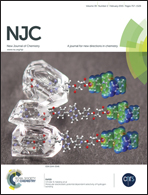Vacuum heat treated titanate nanotubes for visible-light photocatalysis†
Abstract
Visible light-active TiO2(B)/anatase heterojunction nanotubes (NTs) are prepared via a process combining a two-step alkaline hydrothermal technique, ion exchange and heat treatment in a vacuum. The TiO2 NTs inherit the skeleton structural features of NT precursors and thereby lead to the formation of NTs with good crystallinity and large surface area (298 m2 g−1 at 350 °C and 279 m2 g−1 at 400 °C). UV-vis diffuse reflectance and PL measurements confirm the distinct visible light absorption due to bandgap defect states introduced by vacuum treatment. Heat treatment in a vacuum at 350 °C and 400 °C induces the formation of TiO2(B)/anatase heterostructure in the TiO2 NTs as confirmed by HRTEM results. As a result, visible light photocatalytic tests demonstrate that TiO2 NTs vacuum treated at 350 °C and 400 °C exhibit significantly better photocatalytic activity for acetaldehyde degradation and CO2 generation in comparison with commercial Degussa P25 nanoparticles. The high photocatalytic activity can be ascribed to the synergistic effect of high surface area, good crystallinity and efficient charge separation promoted by the TiO2(B)/anatase heterojunction. This study provides an effective approach in improving the visible light photocatalytic activity of TiO2 nanostructures based on the introduction of native bandgap defects and heterostructure via vacuum heat treatment.


 Please wait while we load your content...
Please wait while we load your content...